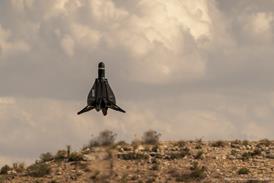The US Air Force could establish a requirement for an armed unmanned air vehicle (UAV) if tests with a General Atomics RQ-1A Predator succeed.
The move to demonstrate an armed Predator results from last year's Operation Allied Force against Yugoslavia. During the conflict, the UAV was equipped with a laser designator in addition to its surveillance sensors and was used to illuminate a concealed Serbian tank, although an attack was not completed because of technical problems with the manned aircraft carrying the weapon.
Further Predators are being equipped with designators, and USAF officials are considering whether armed UAVs "can give joint forces commanders a new option," says Brig Gen Randy Bigum, Air Combat Command director of requirements.
USAF chief of staff Gen Michael Ryan has expressed interest in a small weapons delivery capability to be used for "low-intensity kinds of activities."
The USAF is preparing a demonstration, involving the UAV Battle Lab at Eglin AFB, Florida, and the Predator squadrons at Nellis AFB, Nevada, to establish the physical constraints to arming the vehicle. It is planned to drop an inert weapon from anRQ-1A later this year, with guided weapons testing early next year.
Although the weapon type has not been decided, industry sources suggest the Boeing/Lockheed Martin AGM-114 Hellfire missile, and the in-development Boeing Small Smart Bomb and Lockheed Martin Low Cost Autonomous Attack System are the main candidates. Bigum says more than one weapon might be tested.
Positive test results could lead to an operational requirement, but Bigum warns: "There is some risk associated with this concept because Predator was not designed to carry weapons."
At one time, the US Navy envisioned using the future MRE UAV for suppression of enemy air defences (SEAD), employing a Hellfire-size weapon. Project officials, however, have determined that there are higher-priority missions for the MRE UAV as other systems will be available for SEAD.
USN officials have developed 12 tasks to be considered during the first phase of an MRE feasibility study. Missions include combat identification, battle damage assessment, connectivity, reconnaissance and electronic warfare.
In April, Boeing, General Dynamics, Lockheed Martin and Northrop Grumman were given risk assessment contracts, which are due for completion in February. A development and acquisition programme could be launched at the start of fiscal year 2002, with acquisition beginning in 2006.
Source: Flight International























